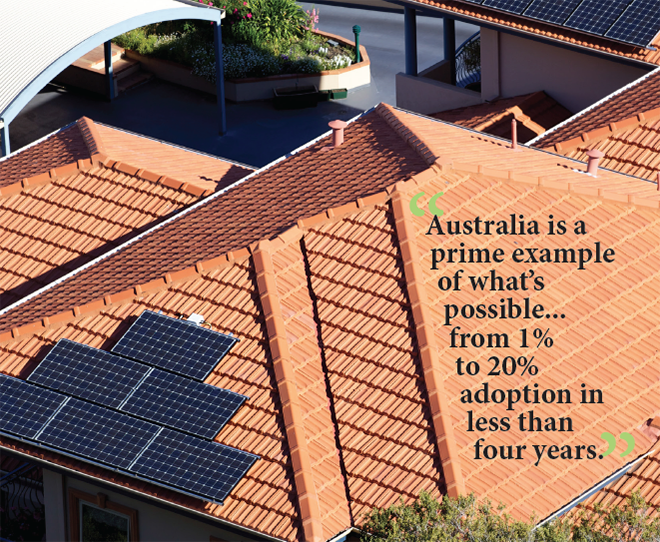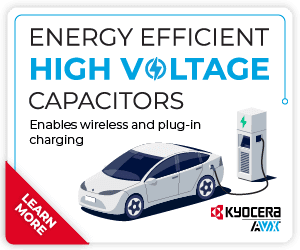The ripples of disruption: Q&A with Mike Calise
The concept of disruption is often discussed in the fields of semiconductors, the internet, data, computers and software. But what about the energy industry? The world has been largely generating and consuming energy the same way for over a century.
Charged talked to Mike Calise, Head of Electric Vehicle Solutions for North America at Schneider Electric, about the early-stage trends of an industry disruptor.

Charged: What’s the premise of disruption, what does it really mean, how is it defined?
Mike Calise: Disruption is typically when a product, technology, or business model innovation that works in one market is applied to a new market, and that causes a game-changing outcome in the new market. The technology or business model for the original market becomes so prevalent that the cost efficiencies gained can now be applied to other markets. Then the new market accepts this disruptive innovation, and even if it doesn’t fit perfectly at first, people begin to use it. Then proliferation occurs and it expands to the point where it becomes highly cost-efficient and well-suited for that new market. That’s kind of a classic view of a disruptive innovation.
To quote Andy Grove, the former CEO of Intel, “If you’re a little better, a little faster and a little cheaper, you’re dead.” The idea is that a disruption really needs to be a game-changer in an industry – at least an order of magnitude that is a 10x level of disruption – otherwise it won’t work. Unless it’s going to create a paradigm shift, it’s more of a sustaining innovation than a disruptive innovation.
When you look at examples of disruption, true disruptions disrupt the entire supply chain, not just one technology. There are many modern examples, like iTunes disrupting CDs, Amazon disrupting brick and mortar book stores, the smart phone, which is a sophisticated computer disrupting the cell phone, and the hand-held camera. Applying the laws of accelerated returns, you can see the impact of these exponential growth curves.

What seems innocuous in the beginning, or not quite disruptive, because it will take more time than expected, eventually can be an incredibly disruptive force. It only took 13 years for the modern car to completely disrupt the horse and buggy as the main transportation technology from 1900 to 1913. Long before Moore’s Law was understood, the laws of accelerated returns and disruptive innovations were prevalent.
Charged: And you see these trends happening now with EVs?
Mike Calise: Absolutely. Rechargeable batteries were designed originally for things like laptops, power tools, hand-held equipment and cell phones. Not too long ago we were all plugging in our computers, and now everybody has a rechargeable notebook computer, tablet and smartphone. The cost of lithium-ion batteries used to power those devices is coming down very quickly as the manufacturing efficiencies increase. Disruption doesn’t necessarily mean that there has to be some technology breakthrough. It could mean that the costs are coming down because of a manufacturing explosion and scale.
Then the early EV innovators asked, “What if we apply this battery technology to a car? Does it make sense as a strategy for greenhouse gas reduction and energy security?” The answer at the time was, “No. It’s way too expensive. There’s no infrastructure, no unique business models, no market, etc.”
But early innovators can always see the big-picture potential, so they tried to put these modern-day batteries in cars as early as the 90s. In fact, electric cars were competing with gas cars back in the early 1900s. Classic of early stage markets, there were a lot of fits and starts and failures. The first attempt at battery-powered cars were not production-quality, and riddled with challenges. Charging companies with government funding put early electric vehicle supply equipment (EVSE) out there that was not ideal, some didn’t work well, and wasn’t in locations where people needed it. Big companies and emerging companies with great ideas and intelligent management invested a lot of capital early on with little returns. Nothing much happens in the early days, but even so, that was an adequate start.

There were early failures because rapid, massive growth was falsely expected, and this is the trap, because disruptive innovations take time. As the venture capital world knows, early failures are expected, but the innovative business models for EVs, energy storage and PV solar are beginning to take shape as a big energy play with very high stakes, and now the game is shifting to an energy-as-a-service model.
EV owners demanding charging installations where their car is parked is a perfect example of why we’re in Market Phase II – the “EV Willing” period. Here people are willing to buy these cars, which spawns more charger demand, and then more EV demand again as we spiral up.
This is the beginning of the disruptive trend, because the cost of batteries decreases and the accessibility of ubiquitous charging increases. EV battery costs started at $1,000 per kWh in 2010. In the first Nissan LEAF, for example, that 24 kWh pack cost about $24,000 to produce. But the expectation is that, in spite of early high costs, the cost of batteries is going to drop 10 times – down from $1,000 to $100 per kWh in time.
Today you will hear some analysts say that batteries will come down in a linear way. It is more likely we are seeing the beginning of a step change. When we have a ten-times reduction in cost, the EV approaches parity with the ICE vehicle. We predict that will be sometime between 2020 and 2025, but maybe sooner. In fact you have parity today in the sport luxury class.
We’re not on a literal Moore’s Law for batteries, because that’s a reference to integrated circuits (functionality of silicon doubles about every 18 months for the same price). We’re not on that trajectory with batteries yet, but we’re certainly on a doubling trajectory. The question is, how many years does it take to double? With disruption trends, that doubling trajectory can actually change in time, and you’re accelerating the acceleration. So within seven years, we may have batteries that give you twice the capacity for the same cost, or the same capacity for half the cost. But then the battery technology may double again in the next five years. Then, it may double again in three years. So after 15 years, we’re on a three-year doubling trajectory. That’s highly disruptive.
Charged: We’re seeing the price of gasoline plummet lately; could this be a death knell for EVs?
Mike Calise: The fact is the price of oil historically has always fluctuated, but it’s the spikes that take the toll on world economies. We get lulled into a sense of security, do nothing about it and then let the next spike impact us again. Even if we go below $2.00/gallon again, we may see delayed EV adoption from the late majority sector, but the early majority will still reap the benefit of even lower energy costs, lower maintenance costs, and innovative financing models. Tesla’s been paying for your vehicular travel miles with corridor Supercharging for the luxury class, and now even Nissan pays for your “fuel” (electricity) with their No Charge to Charge program. Zero cost per gallon for the first two years. That should be front-page news.
Charged: Where does charging infrastructure fit into the EV disruption equation?
Mike Calise: It’s extremely important to create availability of charging infrastructure that impacts effective range. We’re now in the period where people are willing to buy these cars, but they’re still not mainstream. We’re at 1% adoption nationwide, and maybe going to 5% adoption in major California cities, but they are growing in Texas, New York, Illinois and other high-population states. Studies show that EV drivers are known to be very satisfied with their purchases. It won’t be long before the cat’s out of the bag on the EV experience centered around economics, performance and driving pleasure. But it takes time to educate the mainstream, and the mainstream wants more visible available charging stations to reduce range risk.

Our prediction is that by the end of this decade, you’ll be able to charge everywhere without thinking, that’s toward the end of the “EV Able” Market Phase III. That means you’ll be able to charge at home, at work and wherever your car parks or rests, including schools, retail malls, hospitals, destination centers, movie theaters, resorts, ballparks, libraries, civic centers and even gas stations. That means charging without thinking, like your cell phone. By that time you’ll likely have many 100-, 200- and even 400-mile-range EVs. At that time we will see the creation of a market adoption tornado – the beginning of true cost parity across multiple vehicle classes with ICE vehicles. EVs will have great range and the ability to charge everywhere, so overall, they will have excellent effective range.
Remember you can buy a cost-effective Chevy Volt today with 300-mile range that drives 90% of your typical miles on electricity, and can average 95 MPGe. It’s on the horizon that a domino effect will start to eventually make ICE vehicles the minority. We have some predictive models that suggest that by 2040 there may be full disruption, but it may be sooner, in 2030, about the same time it took for horse-and-buggy disruption (see Tony Seba’s book Clean Disruption). The internal combustion engine wastes 75% of its energy in lost heat. The electric motor is 95% efficient. The writing is on the wall.
Some people refer to it as the chicken-and-egg dilemma – it’s really a spiral-up rippling effect of ubiquitous charging and low-cost batteries. Eventually, when we’re able to charge everywhere, the batteries will be sized for the duty cycle of the vehicle. A lot of people ask, “When the batteries are cost-effective and you can get 200 miles out of a vehicle that costs the same as today’s Nissan LEAF, will you still need charging?” Of course you will, because ubiquitous charging will unleash even more adoption, and you can right-size your EV purchase to meet your family use cases. Think commuter, high-schooler, weekender, etc…We’ll get duty cycle sized to the vehicle. That suggests you could buy a brand new very low-cost 100-mile-range vehicle, and that car company may even pay for public charging for you. You will get paid to drive.
You’ll have long-distance, more expensive vehicles like those that Tesla has built. You can pay for 300- or 400-mile range, but at 400 miles you’re done, because humans can’t drive that long without taking a break. When that human takes a coffee, email or bathroom break, the batteries will charge so quickly that within twenty minutes you’ll get another hundred miles. Then you’re ready to go to sleep. So you see that the cost of batteries and the amount of ubiquitous chargers go hand in hand. The ripple effect of multiple disruptive innovations. Our job at Schneider Electric is to put these chargers in everywhere. Today, we are meeting market demands for home, the workplace, retail, hospitals, universities, hotels, ballparks and destination centers. Once installed, drivers appear. Look at Google’s campus, for example. Every time they put in 25 new charging ports 35 new drivers show up with EVs.
Charged: What do these disruption trends suggest about the pace of future EV adoption?
Mike Calise: We were roughly on the order of 1,000 vehicles in 2010. In 2011, when the LEAF and the Volt came out, we were on the order of 10,000. That was a step change, an order of magnitude more in just a year. And the skeptics said, “There’s only 17,000 plug-in cars on the road and 15 million ICE vehicles being sold. You really think you’re going to make noise with these?”
But then it only took a few years – 2011 to 2014 – to get to, effectively, 100,000 plug-in vehicles per year. That’s two orders of magnitude in just a few years. And there are more than 250,000 on the road now in the US, so we’re starting to get an aggregation effect. The biggest challenge now is to go from 100,000 to 1 million plug-in vehicles a year, and that’s not easy, but neither was going from 10,000 to 100,000. One could argue the toughest challenge was to go from 100 to 1000. Those involved in the EV1 do not take this for granted.
We’re predicting by the end of this decade you may see a million cars a year. Historically, disruptive trends take time, but you can already see the accelerated rate of return trajectory. It’s a tornado of integration between vehicles, energy and batteries. That’s really the sort of powerhouse combination that will disrupt oil and other fossil fuels for transportation. It’s all about efficient energy. That’s what Schneider Electric leads the world in.
Charged: So you think solar power is on a similar disruptive path?
Mike Calise: Definitely, and clearly the stakes are enormous. With photovoltaic (PV) solar you can see silicon technology, which is mainstream in the computer, telecom and smartphone industries, applied to the energy industry. The trajectory of solar has been a 14-year history of doubling the installed base every two years. Now energy is an IT problem! It’s on a silicon curve, and now Gordon’s part of the energy conversation, but admittedly it’s more accurately Swanson’s Law.
At the same time, solar PV has a learning curve of 22%. That means that every time that installed base doubles (every two years) the cost of solar PV drops by 22%. Solar has dropped by a factor of 154 since 1970. At the same time, every other source of conventional energy has gone up by 6 to 35 times. Unsubsidized solar is already cheaper than retail electricity prices in many markets around the world: Australia, Chile, Germany, Italy, India (according to Seba’s book Clean Disruption). As solar costs continue to drop and become cheaper than utility prices in more electricity markets, we’ll continue to see the exponential growth curve in solar market adoption.

If you look at this curve, with a doubling occurring about every two years, that means that 16 years from now, solar will be 100% of the world’s energy generation. Disruptive innovation. Globally, installed solar went from 1.4 GW capacity in 2000 to 140 GW capacity in 2013. That’s 100x or 43% compound annual growth rate (CAGR) in 13 years. At that same rate, we could be at 57 TW by 2030. Factoring in conventional baseload equivalents, that equals about 19 TW, about the same as the forecasted world demand for energy by 2030. There will be other factors that delay 100% PV crossover, but silicon-harvested clean energy can follow an explosive adoption trend based on low costs and exponential growth.

Image courtesy of Duncan Rawlinson/Flickr
Australia is a prime example of what’s possible. Australia went from 1% to 20% adoption in less than four years. By comparison, the US population is about 10 times Australia’s population, so the equivalent adoption rate would be 11 million solar installations to stay on the same order of magnitude. Is it possible?
The cost of putting solar on the roof isn’t cheap, but neither was the cost of putting a satellite on the roof for digital broadcast Satellite (DBS). But it took just five years for DirectTV rooftop digital broadcast satellite to go from 1 million to 10 million (10% market penetration), competing against incumbent landline cable companies. The first year saw 1% adoption (sound familiar?). That was when cable was in full force, and a lot of people were still using antennas. That doubled to 2%, then 4%, then 8% and in five years 10% of the North American market went to digital satellite.
The energy market is large enough, and solar can achieve similar rates with new innovative financing models. PV is another disruptive element that’s going to bode well for EVs. So there will be disruption in battery costs, disruption in the amount of vehicles people buy, disruption in the amount of chargers installed, and now we’re seeing the disruptive elements of the way energy is sourced and stored.
The timing of these elements is swayed by political motivations, policy-making, manufacturing realities, world economic trends and other things. So you can’t rely on the trends annually, you have to look at it across many years.
Charged: Are there similarities between EVs and the early days of the automobile?
Mike Calise: Absolutely. We said it took 13 years for the first vehicles to fully disrupt the horse and buggy as the primary means of transportation. I’m sure there were a whole lot of people during that time who would say, “There is no way you’re going to replace Ol’ Nelly. I’ll never afford that. That thing’s unsafe. The roads aren’t built. It’s a hassle to gas up.” If you look in the media over the next 10 years you’ll hear every reformation of those quotes for EVs, if you haven’t already.
Thirteen years for disruption, and what did it take? Innovation first. A new technology was the first step – it’s similar to where we were in 2011 with EVs. But that’s not what causes the disruptive wave. It requires mass-scale manufacturing, infrastructure build-out, and innovative financing models. We’re seeing the same trends for EVs today. Great new EV models launched, battery manufacturing scale, charging infrastructure at home, at work and in public, and new innovative business models tied to loyalty, advertisements, leasing and energy exchange.
In the early 1900s, 100% adoption occurred when roads and gas stations were built and GMAC developed the first auto loan for the homeowner. That’s when it was cheaper to drive a car than it was to feed and pick up after Ol’ Nelly. And that transportation transformation made a huge impact on citywide pollution, because the horses in cities were an unsanitary mess. The parallels are evident, and we’re going to see a similar situation play out for EVs.
Multiply all of this with mass growth in vehicle sensor technology and you see that EVs will be the ideal entry point for autonomous and semi-autonomous vehicles. When you get to autonomy, you’re going to see vehicles save lives and operate in highly efficient ways. They’ll lock in at highway speeds and maximize road use. Maybe even drop you off at the restaurant, go park and charge themselves, then come back and pick you up. And you’ll end up sharing that vehicle with other people and we’ll start to see real efficiency in transportation. That’s a vision many car OEMs share for the future.
Schneider Electric’s energy vision is a systemic approach to solve the global energy dilemma. The problem gets solved with a distributed clean energy solution to transportation and a digitized driver and host experience based on services. With a total system energy management approach, we can exploit the exponential growth of these respective disruptive technologies all working in unison. And we see a very different, clean, quiet, economically strong and efficient world improving decade to decade.
Charged: Will the secondary use of EV batteries play a big role in price reduction?
Mike Calise: In fact, it’s an integral part of the strategy today. Car companies and energy storage companies realize the value of used EV batteries, and some car OEMs have already sold the future of them in contracts. Contrary to those who say these batteries will end up in landfills, the second life of the battery is already predetermined. Again it’s a rippling of disruptions. After 8 to 10 years of using the battery in a vehicle, it may retain 60 to 80 percent of its original capacity. We hear some critics say, “These car batteries are not ideally suited for utilities.” But we’re talking about millions of batteries coming to the market. They won’t be perfect, but they will be cheap and they will compete with battery systems for homes and commercial buildings. So you have a self-fulfilling disruption where contracts are made for second-life batteries, which brings the original cost of the vehicles down to the consumer.
This is where Schneider Electric is uniquely positioned with its strategy to tie buildings and homes to EVs, renewable energy and energy storage. When you’re over capacity with your renewable power sources, the buildings can now shift that load using energy storage, driving up efficiency and saving customers big money from utility demand charges.
Charged: Do you believe that vehicle-to-grid (V2G) and vehicle-to-building (V2B) technology will be widely adopted?
Mike Calise: When you look at the three-prong disruption that’s coming – renewables, energy storage and EVs – you can see that those electrons are all fungible. They can be traded quickly among those three elements. All bringing costs down, all self-fulfilling the exponential growth. And then you will have an expansion of a concept that we call “swarming energy.” Think of it as a “flash mob” of EV drivers. This is a disruptive business model that can go even further using V2G and V2B.

In the future, your employer may incentivize you to drive a company fleet car. “Don’t buy your own car, use ours.” It’s great for employee retention, and there are trade-offs in terms of loyalty and currency – which is the distributed energy. Employees will say, “When I’m parked and plugged in at work at 4 o’clock, I don’t mind if the building uses 10% of my battery capacity. I have 200 miles of range and only a 30-mile commute.” Then you can begin to swarm energy by harvesting at night with wind or during the day with solar, and use it whenever you need it. Roaming energy on demand. This is still years away, but we have seen numerous pilots, so the trajectory has already started. Again, disruptive innovations take time.
Right now Schneider Electric is connecting the workplace and public charging with the homeowner through connectivity. We call it EVlink because we’re linking EVs in the home and in public with the connected home and building energy management systems, and it’s all reconciled in the cloud delivered in a service model.
The slow but steady disruption is already happening. Once it gains momentum you can’t stop it, so you better be on the right side of it.
Charged: What can we actually do today with all these disruptive trends happening?
Mike Calise: Right now, the key is to stay inspired and don’t give up. The best thing you can do is stay focused on the now. If you’re on the supplier side, focus on this quarter. Sell, sell, sell. Finance, or donate charging equipment, electric vehicles, and solar. If you’re on the buying side, get chargers for your home or facility. Investigate the economics of rooftop solar and lease or buy EVs and PVs. The vision is intact, but without the day-to-day hard work, it may not become reality because some people cannot understand how we’ll get there. So, create your company or personal strategy knowing how the rippling effect of disruptive innovations can change the big game for good.
Connect with Mike Calise on Twitter and continue the dialogue: @MCaliseEVlink
This article originally appeared in Charged Issue 16 –November/December 2014












































































































